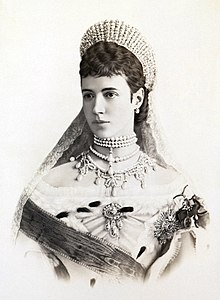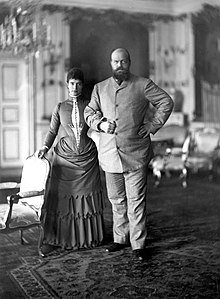Dagmar of Denmark (1847-1928)

Marie Sophie Frederikke Dagmar, Princess of Denmark (born November 26, 1847 at Amalienborg Palace in Copenhagen , † October 13, 1928 at Hvidøre Palace near Copenhagen) was the wife of Emperor Alexander III. as Maria Fjodorovna ( Russian Мария Фёдоровна ), also Maria Feodorovna , from 1881 to 1894 Empress of Russia . She was the mother of Nicholas II , the last Russian tsar.
Life
Origin and youth
Dagmar was born as the fourth child and second oldest daughter of Prince Christian of Schleswig-Holstein-Sonderburg-Glücksburg and his wife Louise of Hesse . She was baptized in the name of her relative, the queen widow Marie Sophie Friederike of Denmark . Her father became heir to the Danish throne in 1853 and after the death of Frederick VII in 1863 as Christian IX. King of Denmark. Through the marriage of her five siblings, she was related to numerous ruling houses in Europe. Her older sister Alexandra became the wife of King Edward VII of Great Britain and Ireland, which explains the striking external similarity between her son Emperor Nicholas II and her nephew King George V of Great Britain and Ireland . Dagmar, who was called Minnie in the family , was raised together with her sister Alexandra. The two princesses shared a room and received an education that corresponded to a woman of the time. They also received swimming lessons from the Swedish swimming pioneer Nancy Edberg.
family
In the summer of 1864, Princess Dagmar was betrothed to Tsarevich Nikolai , son of Alexander II of Russia . The wedding did not take place, however, as Nikolai fell ill and died in Nice in April 1865. Consoled by Nikolai's father after her loss, she became engaged to Nikolai's younger brother and new Tsarevich Alexander the following June . Dagmar converted to the Russian Orthodox faith and from then on called himself Marija Fjodorovna ( Russian Мария Фёдоровна ). Her wedding to Alexander took place on November 9, 1866 in Saint Petersburg . The newly wed couple moved to the Anichkov Palace in St. Petersburg, where they lived for the next fifteen years. The marriage had six children:
- Nicholas II (1868–1918), Tsar of Russia
- Alexander (1869-1870)
- Georgi (1871-1899)
- Xenia (1875-1960)
- Michail (1878-1918)
- Olga (1882-1960)
Through her marriage to the heir to the throne, Maria Feodorovna became Tsarina of Russia after the death of her father-in-law in a bomb attack (March 13, 1881). She and her husband were crowned in the Kremlin in Moscow on May 27, 1883 . Due to concerns for their safety, the family moved to Gatchina Palace outside of St. Petersburg a short time later . She was reserved about the marriage plans of her son and future emperor Nikolaus with Alix von Hessen-Darmstadt . After the death of her husband at the age of only 49 on November 1, 1894 and the wedding of Nicholas and Alexandra in the same month, she retired to the Anichkov Palace.
She was less interested in politics, but more interested in her family and charity. The only exception to their reluctance to engage in political affairs was the open demonstration of their violent dislike of Germany after the First World War broke out.
Return to Denmark
After the outbreak of the Russian Civil War , Maria Fyodorovna was brought to safety from the Crimea on the HMS Marlborough at the urgent request of her sister Alexandra . She returned to Denmark via England and settled in the summer residence Hvidøre near Copenhagen. From there it financed the investigations of the White Army soldier Nikolai Alexejewitsch Sokolow , who was investigating the whereabouts of the Tsar's family after the October Revolution . Although Sokolov came to the conclusion in 1924 that Nicholas II was dead, she firmly believed that her son was still alive until she died.
She died on October 13, 1928 and was buried in the family crypt of the Danish kings in Roskilde Cathedral. On September 28, 2006, her bones were transferred to the family crypt of the imperial family in the Peter and Paul Cathedral in Saint Petersburg.
literature
- Coryne Hall: Little Mother of Russia: A Biography of Empress Marie Fedorovna (1847-1928) . New York et al. a. 2001, ISBN 978-0-8419-1421-6 .
ancestors
| Friedrich Karl Ludwig of Schleswig-Holstein (1757–1816) | |||||||||||||
| Friedrich Wilhelm of Schleswig-Holstein (1785–1831) | |||||||||||||
| Friederike von Schlieben (1757–1827) | |||||||||||||
| Christian IX King of Denmark (1818–1906) | |||||||||||||
| Karl of Hessen-Kassel (1744–1836) | |||||||||||||
| Luise Karoline of Hessen-Kassel (1789–1867) | |||||||||||||
| Louise of Denmark (1750-1831) | |||||||||||||
| Dagmar of Denmark | |||||||||||||
| Friedrich von Hessen-Kassel (Rumpenheim) (1747–1837) | |||||||||||||
| Wilhelm of Hesse (Rumpenheim) (1787–1867) | |||||||||||||
| Karoline Polyxene of Nassau-Usingen (1762–1823) | |||||||||||||
| Louise of Hesse (1817–1898) | |||||||||||||
| Friedrich Hereditary Prince of Denmark (1753–1805) | |||||||||||||
| Louise Charlotte of Denmark (1789–1864) | |||||||||||||
| Sophie Friederike von Mecklenburg (1758–1794) | |||||||||||||
Web links
- "Dagmaria" society
- Biography on www.alexanderpalace.org (English)
- Newspaper article about Dagmar of Denmark in the 20th century press kit of the ZBW - Leibniz Information Center for Economics .
| predecessor | Office | Successor |
|---|---|---|
| Maria Alexandrovna | Empress of Russia 1881–1894 |
Alexandra Feodorovna |
| personal data | |
|---|---|
| SURNAME | Dagmar of Denmark |
| ALTERNATIVE NAMES | Feodorovna, Maria |
| BRIEF DESCRIPTION | russian empress |
| DATE OF BIRTH | November 26, 1847 |
| PLACE OF BIRTH | Copenhagen |
| DATE OF DEATH | October 13, 1928 |
| Place of death | Hvidøre , Denmark |


